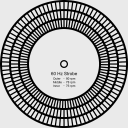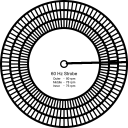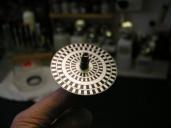
It allows to keep PV going, with more focus towards AI, but keeping be one of the few truly independent places.
-
The attack and decay area of a mechanical shutter, which is completely out of focus, is very different from the sharp edges of an electronic shutter. All else being equal (speed, display etc., no compression) this will be the sole reason for a perceptual difference. As I mentioned before, the Tessive filter tries to cure this.
An interesting observation: with HDRx on the RED cameras (using "Magic Blend") it looks a bit better, since that is introducing some softness to the trailing edge of shutter.
GOP compression will introduce additional temporal artifacts, only intra compression is free of these. That said, some of the low GOP settings here at VK's are very good in that respect.
And the "hula dance" is probably RS, right.
-
My solution for GH2 is to shoot 24p at 1/30 shutter. Takes care of the exaggerated strobbing for me, yet still looks not too smudgy (again, to my eye.)
-
Roberto and others here - Thanks for all this. It is a VERY valid topic. I only recently started shooting digital. I have a gh2 and a few sharp lenses, mainly the pana 25mm 1.4. I always love slow pans, crane moves and or dolly work. In 35mm film, it was possible to move through a jungle or rainforest panning and tilting very slow (well within mathematical specs covered in asc manual). Never had I a 24fps/180 degree shot exhibiting the same strobbing and/or "farkle" (great term!). This summer I used a Red Epic and Zeiss superspeeds. There was less of that effect, but still some. The bottom of the frame seems to do a little hula dance during slow pans. Could that be the rolling shutter? However, when I shoot the same thing with the lens out of focus (same shutter speed) it seems to tame the effect. I wouldn't be surprised if a diffusion filter might help. It's been so long since I've used those. Now I will do some fiddling with 40, 30 shutter speeds. For those of us who have spent decades using film cameras are very aware of exaggerated (blurring) effect caused by using shutter angles greater than 180. I do believe that it's a twofold problem 1, rolling shutter, 2, lack of the natural attenuation of a rotating mechanical shutter. And yes, monitors and video cards might play a role too. If there is a way to solve this in-camera (not in post) we all would be delighted. Thanks again! Bill
-
[edit]
-
with Motion2 turned all the way up, all of our 24p GH2 mts footage plays perfectly
It would be nice if we all had players with that kind of error-correction. But the stuttering is still there, especially if the individual frames are not blurred as with the several examples of downloadable mts files posted on Vimeo.
-
Ok. You guys are getting pretty technical. I think there is obviously something with the GH2 strobe that is more pronounced then in other 1080p video cameras.
I found a program, Splash PRO EX, which has a feature called Motion2 (hardware acceleration) which claims 24/25/30p to 60p conversion ...
it only works on Windows... you can download free 30 day trial... http://mirillis.com/en/products/splashexport.html
Unfortunately, it only works on playback, but with Motion2 turned all the way up, all of our 24p GH2 mts footage plays perfectly, with absolutely no strobe at all, even on fast pans. (edit. Thats's 24p 1/60 -2 sharpness). There is even an added detail boost that makes it look very sharp. Our footage looks amazing!
So, it leads me to believe the GH2's raw .mts is grabbing all the necessary information, but the computer hardware/monitor can't 'handle' it by default?
Also, as another example, if I crop our footage in Premiere, by say 25%, whether its the raw mts or even exported h264, the strobing is not present. That's a totally useless fix, of course, but it seems to point to computer hardware, would it not?
I'm stumped, but perhaps someone with more knowledge could test the Splash PRO EX software and determine what its doing right?
-
You should be able to test your shutter speed yourself, using a high-quality, belt-driven vinyl record turntable which has speed adjustment and either has those black & white markings on the side, or else you add your own as in the picture. First you calibrate your record player using an incandescent light source. Next, make a good strong mark on the turntable. (radial will be good, we'll be measuring angles here). Finally, shoot some video of your rotating turntable using only available light. Record the blurred angle (measured with a compass, protractor, a pair of scissors....)
The rest is mathematics.
 disc50hz.png640 x 640 - 30K
disc50hz.png640 x 640 - 30K
 disc60hz.png640 x 640 - 32K
disc60hz.png640 x 640 - 32K
 disc60hz2.png640 x 640 - 62K
disc60hz2.png640 x 640 - 62K -
Since your post I have finally got hold of a DVD of this movie (and it’s still as much fun to see as it was in 1979—thanks for the reminder).
“Stwike him, Centuwion, vewy wuffly!”
Yep, it’s a brilliant movie in many respects.
My screenshots come from a scaled down HD source (1080p > 720p) @ 23.98fps, not a DVD, though. Since it has more detail and sharpness than the SD version, it’s probably prone to more strobing. I agree there’s plenty of stutter in other scenes of this and other movies. People seem to only notice it when you draw their attention to the fact, or when they begin shooting films themselves. Then they begin to blame the GH2, the RED, digital, display sync frequencies, and everybody and his brother.
-
Just yesterday, completely by accident noticed heavy strobing and judder in a scene in Life of Brian (1979)
Since your post I have finally got hold of a DVD of this movie - (and it's still as much fun to see as it was in 1979- thanks for the reminder).
No, I don't see any strobing on that particular scene, but I do see stutter in other scenes. Most of the DVD looks very good. But there is also occasional strobing, chromatic aberration, light-level flickering and more, all associated with what I reminds me of the early "Hopping Patch" CRT telecine copies we got for broadcast back in the early 80's. This was before anyone had a [Betamax], TV was pretty terrible - and 24>25 fps (PAL) conversion was brutal or else ignored. It all goes with the 1970's look, really, along with the frequent zooms!! ;-)
What disappoints me is how hard it was to get a copy at all of this classic, let alone a re-mastered Blu-Ray, which would be a better reference to the original.
-Not that it would be a faithful image! Lately, even colour films from the 1940's are being re-mastered with such grain-free fidelity and smoothness that I imagine there will have been all kinds of interpolation and other stuff applied.
-
You got it :)
"A" had CC Force Motion Blur applied. "B" shows the original footage at 1/50 shutter.
So it looks like subjective test prefers the longer motion blur.
-
A looks a bit smoother to me - (but I'd rather see a steady camera shooting a side-view of steadily moving traffic).
-
Yup. 1/30 looks fine to me. (Just don't freeze any frames in post, they'll look blurry. If that's what you need, shoot that part with high shutter speed.) Normal playback at 24p looks pleasing to me now.
BTW... which one do you, subjectively, like here - A or B?
https://docs.google.com/open?id=0B8-e5MfdPT29VkkzR2NlMU9PWXc
-
If I were you, mo7ies, I'd also be using 1/30 if it works.
1/30 is supposed to produce too much blur on barely moving subjects when you don't want it - (but after all, plenty of users are reporting shutters not doing what they're supposed to do; "not blurring at all" seems to be a big one).
Until some real tests are done with spinning test charts, we don't know if 1/30 is really 1/30 anyway.

 p4041755.jpg640 x 480 - 29K
p4041755.jpg640 x 480 - 29K -
I didn't see a major difference from 1/50 to 1/40 in my previous tests.
Besides, 1/30 should work better with artificial lighting in places that utilize 60Hz AC power (US).
-
@mo7ies did i miss something..? why didn't you try 1/40?
-
OK, did some outdoor tests in bright sun light. With ND filters - lens wide open; without ND filters - lens at F22.
Shutter 1/50 vs 1/30.
1/50 shutter: ND or no ND, same thing - strobe city. Now, it is not completely atrocious unless you zoom in and hand-hold the camera. But to my eye, still jarring.
1/30 shutter: freeze-frame looks unnatural - motion blur too pronounced, resulting in weird image ghosting. BUT! At the intended 24p playback - I like it way, way better than the 1/50.
So there, looks like there's a simple solution. Shoot 24p at 1/30 shutter, get all the pleasant motion (at the normal playback framerate).
-
I'd like to see a comparison of stuttering footage with long GOP settings and then same subject with short GOP settings, everything else unchanged.
-
HMIs with magnetic ballasts, you mean? Because electronic ballast HMIs should not be susceptible to flickering anywhere near the low 60Hz frequency, AFAIK...
-
In my experience, syncing to the power line frequency is only necessary if you have hmi's, fluorescent, or street lights. Tungsten won't make a difference. But, it's not always something that will show up on a monitor so it's good to play it safe. I would not use a 1/30 for general shooting. There will be a lot of motion blur and to me it's borderline smearing. @mo7ies I don't think there's a lag as you describe. If you imagine a sensor 25 pixel rows high, each row is turned 'on' for the time that the shutter speed is set to, in sequence, one pixel row per millisecond. If you could see a visual representation it would look like a crowd doing the wave at a stadium. I think the subtle skew from normal camera movement tricks your brain into thinking the straight line should start 'there', but then it pops up just a little bit over to one side or the other, and we can interpret it as strobing. And it's not just straight lines, it's any shape. Of course I could be totally wrong. :)
-
I think I personally am leaning towards the 1/30 shutter now (on 24p).
Did some indoor tests, and they look fine to me (but so did 1/40 shutter indoor tests.) So no, I don't think I'm getting that way exaggerated motion blur I was afraid of, at 1/30.
Next up, will test it tomorrow outdoors and se how it goes. If it flies, I suppose will shoot at 1/30 from now on. Sure helps in low light, too! - plus, @LPowell commands to use it to combat artificial lighst flicker, so there! :)
-
More info on lighting flicker to be found on threads like "Shooting 24p in 50Hz electricity system countries" http://www.personal-view.com/talks/discussion/1444/shooting-24p-in-50hz-electricity-system-countries-/p1
-
@mo7ies If you shoot at 1/60 sec shutter, it doesn't matter what the phase angle of the 60hz power line is - you'll capture a full cycle of 60hz illumination regardless of what phase angle the shutter happens to open at. This is why a 1/60 shutter effectively eliminates 60hz power frequency strobing.
The amount of motion blur is not proportional to "shutter angle", it's determined by the absolute duration of time the shutter is open for each frame. You will see the same amount of motion blur with a 1/60 second shutter at any frame rate you choose. "180-degree shutter" is a motion picture film camera term that described how the rotating mechanical shutter operated. Digital video cameras use a completely different method of controlling the shutter that produces a fixed shutter speed, regardless of frame rate.
-
@LPowell "The electronic shutter is triggered at the start of each frame and as long as its duration is not longer than the frame rate, the shutter remains open for the same amount of time, regardless of frame rate. "
Yes, but the same shutter will produce different angle on different framerates, thus affecting motion blur - will it not.
That's why for 30p we need 1/60 shutter to get the "normal blur" look = 180 deg shutter.
And for 24p (what we are discussing here) 1/48 shutter which we approximate with 1/50 on GH2, for the same "normal blur" look = 180 deg shutter.
Except, we still seem to get the strobe effect and NOT a normal blur look, as discussed above.
So as a compromise, methink we should use 24p with 1/40 shutter generally, and then apply Force Motion Blur effect in post, selectively, to the troublesome-looking shots.
BTW, I'm not a huge believer it using 1/60 shutter for 60Hz light - because without also synchronizing the Phases, the two frequencies (shutter vs light pulsation) will still produce artifacts, IMHO. But this is for a different discussion, I guess :)
-
@mo7ies In my experience, frame rate is not the issue, it's the power frequency of your lights. The electronic shutter is triggered at the start of each frame and as long as its duration is not longer than the frame rate, the shutter remains open for the same amount of time, regardless of frame rate. In order to avoid power frequency strobing, you need to capture exactly one (or two) full cycles of 60hz power (in NTSC regions) in each frame.
-
Now, I assume you are talking about 30p recording with 1/60 shutter, correct?
I was mostly concerned about the 24p recording - in which case do you think 1/30 shutter is universally appropriate or not?
Howdy, Stranger!
It looks like you're new here. If you want to get involved, click one of these buttons!
Categories
- Topics List23,980
- Blog5,725
- General and News1,352
- Hacks and Patches1,152
- ↳ Top Settings33
- ↳ Beginners255
- ↳ Archives402
- ↳ Hacks News and Development56
- Cameras2,362
- ↳ Panasonic992
- ↳ Canon118
- ↳ Sony156
- ↳ Nikon96
- ↳ Pentax and Samsung70
- ↳ Olympus and Fujifilm100
- ↳ Compacts and Camcorders300
- ↳ Smartphones for video97
- ↳ Pro Video Cameras191
- ↳ BlackMagic and other raw cameras115
- Skill1,960
- ↳ Business and distribution66
- ↳ Preparation, scripts and legal38
- ↳ Art149
- ↳ Import, Convert, Exporting291
- ↳ Editors191
- ↳ Effects and stunts115
- ↳ Color grading197
- ↳ Sound and Music280
- ↳ Lighting96
- ↳ Software and storage tips266
- Gear5,417
- ↳ Filters, Adapters, Matte boxes344
- ↳ Lenses1,580
- ↳ Follow focus and gears93
- ↳ Sound498
- ↳ Lighting gear314
- ↳ Camera movement230
- ↳ Gimbals and copters302
- ↳ Rigs and related stuff273
- ↳ Power solutions83
- ↳ Monitors and viewfinders340
- ↳ Tripods and fluid heads139
- ↳ Storage286
- ↳ Computers and studio gear560
- ↳ VR and 3D248
- Showcase1,859
- Marketplace2,834
- Offtopic1,319








